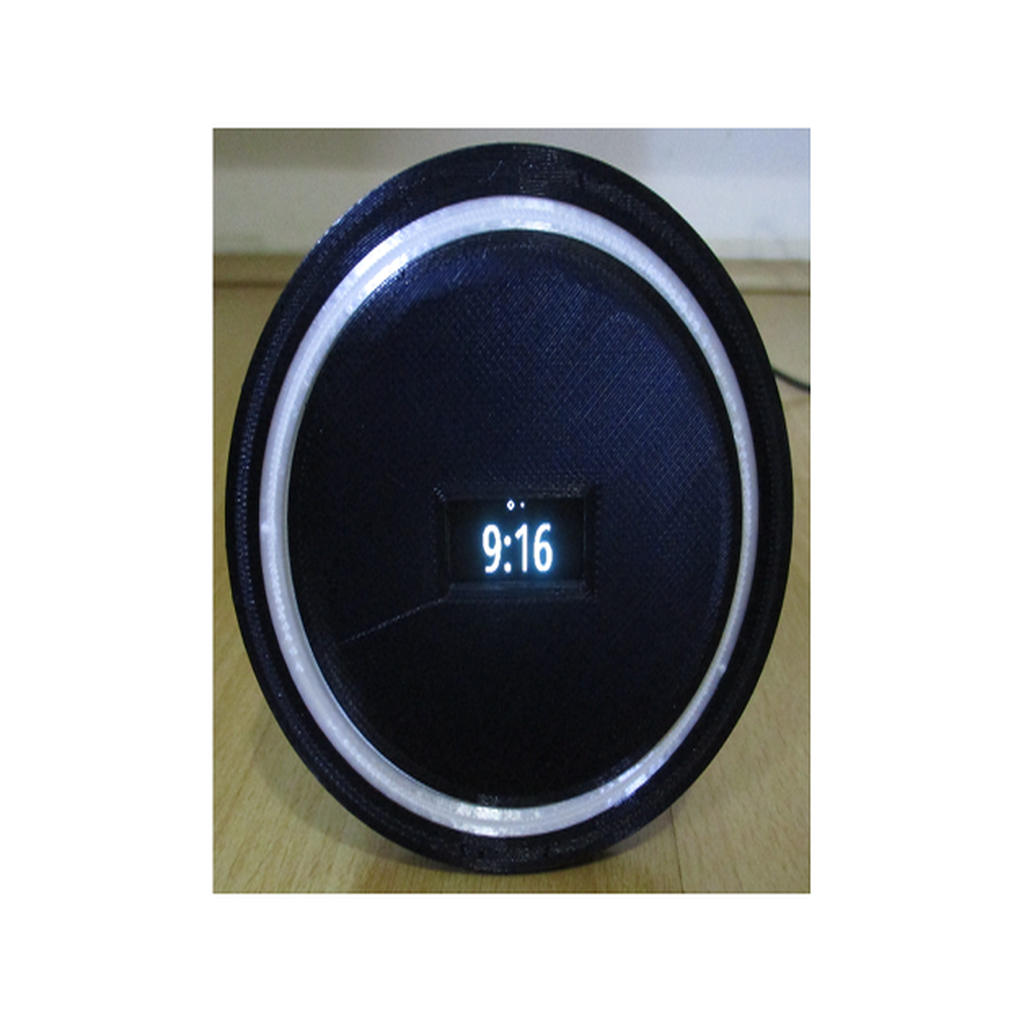
Neopixel MQTT Alarm Clock with Buzzer, RTC, Temperature, Humidity and Pressure sensor
prusaprinters
<p>Have been working on this clock for a little while and needed an enclosure, and this one does the job very nicely (thanks to creator), and I used part of the Desktop widget clock for the screen insertion into the face (again, thank you).</p> <p>The original body was designed for a dual colour printer, so I've modified the design to include a slot in diffuser, and have also changed the design of the back to allow extra space for electronics - it's a tight fit, but all of the modules can fit in there.</p> <p>I liked the idea of being woken gradually, and so the Neopixel ring can be triggered by an MQTT command independently of the buzzer. The clock only checks periodically so alarms may be out by a few seconds - but I can live with that.</p> <p> <figure class="media"> <oembed url="https://youtu.be/yKDOEWcy0uQ"></oembed> </figure> </p> <p>I have mine set up with a node-red flow that uses Bigtimer to trigger the light, and a delay that then sounds the buzzer 5 minutes later.</p> <p>The clock also contains a DS3231 RTC module so that if power is disconnected, then when plugged in again it shows the correct time (there is scope for a battery version that will work with no mains and use eg a RTC Alarm, but I've not done that). I've also included a BME280 that is used for temperature, humidity and pressure readings.</p> <p>The time and temperature is shown on the SSD1306 OLE display via sliding frames, each shown for 5 seconds.</p> <p>The code is cobbled together from an SSD1306 example script that showed the sliding frames of a clock, and the WS2812FX library that circles through approx 40 light animation effects. The exposure on the video is a little out, as the clock lights appear much brighter to my eyes.</p> <p>When the light displays, or the buzzer sounds, a button on the clock can be pressed to cancel it/them, and sends a message back to the MQTT server to cancel the alarm.</p> <p>Components used are :-</p> <p>Wemos D1 Mini</p> <p>Buzzer</p> <p>Neopixel ring (I used an RGBW 24 pixel unit, 6500k, OD 92mm, ID 76mm)</p> <p>SSD1306 (I2C) 3.3V</p> <p>DS3231 RTC (I2C) 3.3V</p> <p>BME280 (I2C) 3.3V</p> <p>Switch</p> <p>10k resistor</p> <p>2 screws</p> <p>The circuit diagram is included.</p> <p>Printing is straightforward and there's no need for supports (except for the diffuser), any spans should be OK without them.</p> <p>There's a little slack to allow the diffuser to fit. If your tolerances are a little out, and the face isn't tight in the body when the screws are tightened, a couple of drops of superglue at the back edge should be sufficient to tighten the clock face to the diffuser.</p> <p>Ensure all components are insulated, I used heat shrink and kapton tape.</p> <p>Check for overheating and good air circulation.</p> <p>The code for the Wemos D1 Mini is in the AlarmClock.ino file, just copy and past it into the Arduino IDE to compile, use the library manager to add any libraries you don't have installed. You will need to include your wifi details, and your mqtt broker details, and if you use a different neopixel ring, you will need to adust lines 29 and 32 to the type of ring used.</p> <p>A demo node-red flow is also included in a text file - just copy it and import it into node-red using the clipboard option.</p> <h3>Print Settings</h3> <p><strong>Printer Brand:</strong></p> <p>Creality</p> <p class="detail-setting printer"><strong>Printer: </strong> <div><p>CR-10</p></div> <p><strong>Rafts:</strong></p> <p>No</p> <p class="detail-setting supports"><strong>Supports: </strong> <div><p>No</p></div> <p><strong>Resolution:</strong></p> <p>0.2</p> <p><strong>Filament:</strong></p> Generic PLA <p><br/> <p class="detail-setting notes"><strong>Notes: </strong></p> </p><div><p>Used generic black PLA for most of the prints.</p> The diffuser insert should be printed with minimal infil, I used 5% otherwise it becomes too opaque - I used a silk-like white PLA though plain white PLA should be just fine. <p>Print the diffuser with the 4 standoffs on the bed and support under the rest of the ring. I used a wall thickness of 3 and 5% infill. If your diffuser is not letting sufficient light through, then try reducing the number of walls or just the top and bottom layers, reducing bottom layers will probably be best as it will not spoil the front look.</p> </div></p></p> Category: Electronics
With this file you will be able to print Neopixel MQTT Alarm Clock with Buzzer, RTC, Temperature, Humidity and Pressure sensor with your 3D printer. Click on the button and save the file on your computer to work, edit or customize your design. You can also find more 3D designs for printers on Neopixel MQTT Alarm Clock with Buzzer, RTC, Temperature, Humidity and Pressure sensor.
